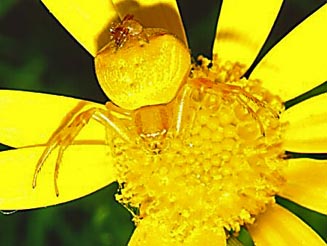|
Thomisus (flower crab spiders) Life
> Eukaryotes
>
Opisthokonta >
Metazoa
(animals) > Bilateria > Ecdysozoa > Panarthropoda > Tritocerebra >
Arthropoda > Arachnomorpha > Cheliceriformes > Chelicerata > Euchelicerata
> Arachnida > Araneae
> Araneomorpha > Family: Thomisidae (crab spiders)
 |
 |
 |
| Top: Thomisus female with
male waiting on her abdomen to mate. Bottom: Thomisus sp. female.
[image N. Larsen ©] |
White Thomisus with bee
prey. [image N. Larsen ©] |
The most conspicuous genus in the family. Spiders are short
and squat, ranging in size from 3-11mm. The glabrous integument (exoskeleton) is
cryptically coloured, taking on the colour of its surroundings. Thomisus
is able to undergo white to yellow or pink colour changes depending on the
flower they are sitting on. This colour change facilitates camouflage on flower
ambush sites and is completed within 2 days. While colour patterns are species
specific, colours can vary. Not all species have this colour changing ability as
some species occur on bark or among grass seeds and thus are a cryptic brown.
The first and second pairs of legs are noticeably longer and thicker than the
last 2 pairs and are used for prey capture. The abdomen is triangular in shape,
being widest posteriorly. The lateral eyes are situated on tubercles.
Thomisus is a sedentary spider and is usually
noticed only when one sees a strangely positioned, usually upside down, insect
and upon investigation, the insect can be seen to be in the grips of a spider.
Thomisus waits for flying insects to settle, patient and motionless, with
outstretched legs. She can detect them from 20mm and when within a range of
5-10mm, Thomisus closes her powerful front legs, catching the insect
which can be up to 3 times her size. The insect is then bitten behind the head
and killed. The insides are dissolved with enzymes and sucked from the
exoskeleton and the empty, perfect form of the insect is dropped to the ground.
Often a small brown male can be seen riding piggyback on
the female (see top left photo). The male seeks out a subadult female and waits
for her final moult at which time she is incapable of resisting his advances or
attacking him. He makes his move and mates and then leaves to seek another
defenseless mate. The females probably secretes pheromones before the moult
which attracts the males. After mating, she lays her eggs in a leaf curled much
like an ice cream cone. She guards the eggs without eating and dies later
leaving her offspring to disperse.
Text by Norman Larsen
© |
